Dainty and enchanting, Dicentra, commonly known as bleeding hearts, adds a touch of whimsy to any garden landscape. These unique plants, with their heart-shaped flowers dangling delicately from arching stems, have captured the hearts of gardeners worldwide. In this comprehensive guide, we’ll delve into everything you need to know about caring for Dicentra, from understanding its varieties to mastering its growing conditions and maintenance.
Dicentra Varieties and Cultivars
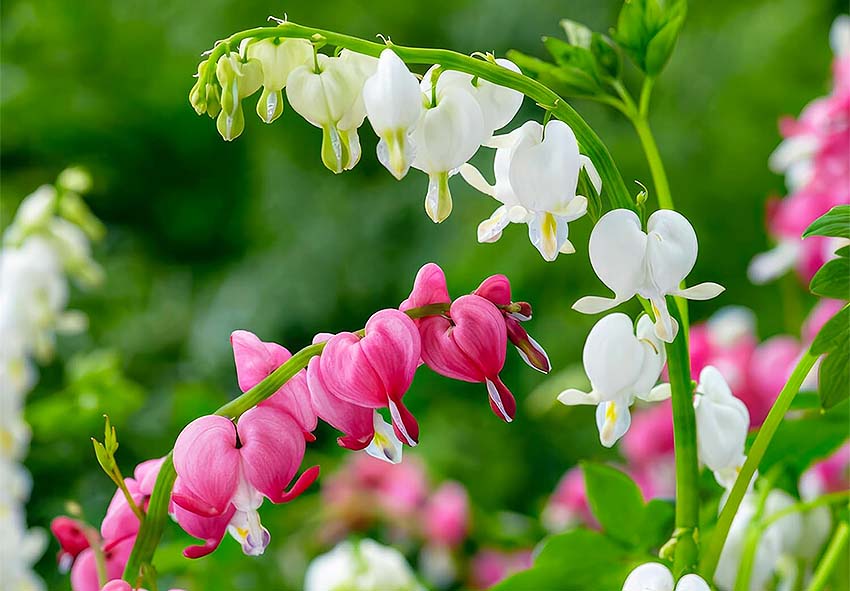
Dicentra encompasses a diverse array of species and cultivars, each with its own unique charm and characteristics. In this section, we’ll explore some of the most beloved Dicentra varieties, from classic favorites to exciting new cultivars and hybrids. Whether you’re drawn to the timeless elegance of the Old-Fashioned Bleeding Heart or intrigued by the vibrant hues of modern hybrids, there’s a Dicentra plant to suit every garden style and preference.
Common Dicentra Varieties
Among the most beloved Dicentra species is the Dicentra spectabilis, affectionately known as the Old-Fashioned Bleeding Heart. Its classic, heart-shaped pink flowers are a timeless favorite in cottage gardens. Another popular variety is the Dicentra eximia, or Fringed Bleeding Heart, prized for its fern-like foliage and delicate, nodding blooms in shades of pink and white. In this table, you can find more useful information about it:
| Botanical Name | Usage | Color | Flowering Period | Particularities |
| Dicentra spectabilis | Garden beds, borders | Pink, white | Spring to early summer | Classic, heart-shaped blooms |
| Dicentra eximia | Woodland gardens, containers | Pink, red | Late spring to summer | Compact habit, fern-like foliage |
| Dicentra formosa | Shade gardens, rockeries | Pink, red, white | Spring to early summer | Tolerates dry shade, mounding growth |
| Dicentra cucullaria | Native gardens, naturalized areas | White, cream | Early spring | Dwarf species, ephemeral blooms |
| Dicentra ‘Gold Heart’ | Garden beds, borders | Pink, yellow | Late spring to summer | Golden foliage, contrasting blooms |
New Cultivars and Hybrids
In recent years, breeders have introduced an array of exciting cultivars and hybrids of Dicentra, offering gardeners a plethora of options to explore. From the vibrant ‘King of Hearts’ with its crimson blooms to the elegant ‘Gold Heart’ adorned with golden foliage, these newer varieties bring fresh colors and forms to the Dicentra family.
Growing Conditions for Dicentra
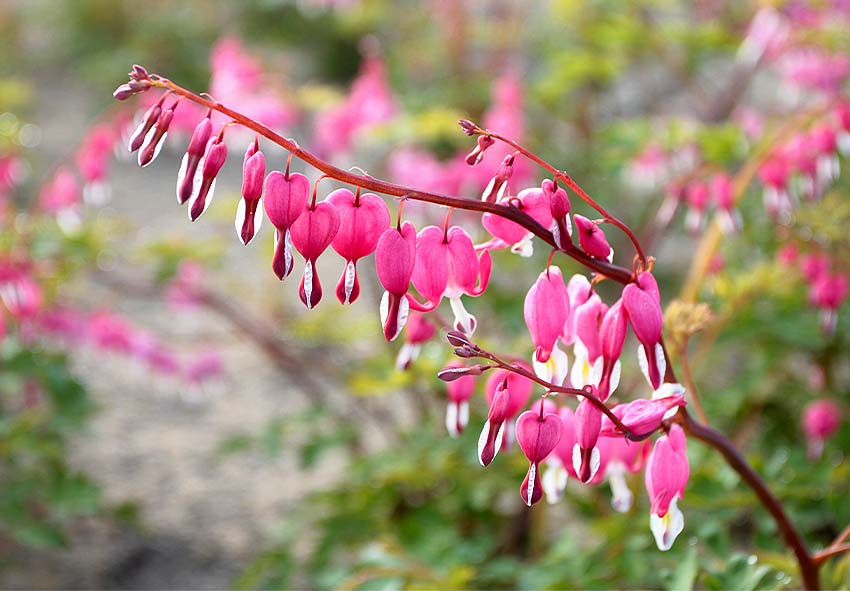
- Sunlight Requirements
Dicentra thrives in partial to full shade, making it an excellent choice for shady spots in the garden. While some varieties can tolerate more sunlight, they generally prefer dappled shade or filtered sunlight to prevent scorching of the delicate foliage and flowers.
- Soil Preferences
When it comes to soil, Dicentra prefers rich, well-draining soil with plenty of organic matter. A slightly acidic to neutral pH is ideal for optimal growth, and incorporating compost or aged manure into the soil can help improve its fertility and texture.
- Watering Needs
Dicentra plants appreciate consistently moist soil, especially during the growing season. However, it’s crucial to avoid waterlogged conditions, as excessive moisture can lead to root rot and other problems. Water deeply and regularly, particularly during dry spells, but allow the soil to dry out slightly between waterings to prevent overwatering.
Planting and Propagation
Planting and propagating Dicentra, commonly known as bleeding hearts, is an essential aspect of caring for these enchanting plants. In this section, we’ll provide practical guidance on how to successfully plant Dicentra in your garden and propagate new plants to expand your collection. Whether you’re starting from seeds, division, or cuttings, mastering the art of planting and propagation will ensure a thriving garden filled with these delicate, heart-shaped blooms.
Planting Dicentra
When planting Dicentra in the garden, it’s crucial to select a location that provides the ideal balance of shade and sunlight. Dicentra thrives in partial to full shade, making it perfect for shaded borders, woodland gardens, or beneath trees. Ensure that the soil is well-draining, as Dicentra plants are susceptible to root rot in waterlogged conditions.
Start by preparing the planting area by digging a hole slightly larger than the root ball of the Dicentra plant. Loosen the soil at the bottom of the hole to encourage root penetration and establishment. If planting multiple Dicentra plants, space them according to their mature size to allow for proper airflow and prevent overcrowding.
Before planting, gently remove the Dicentra plant from its container, taking care not to disturb the roots excessively. If the roots are tightly bound, gently tease them apart to encourage outward growth. Place the plant in the center of the prepared hole, ensuring that the top of the root ball is level with the surrounding soil.
Backfill the hole with soil, firming it gently around the base of the plant to provide support and eliminate air pockets. Water the newly planted Dicentra thoroughly to settle the soil around the roots and promote establishment. Apply a layer of organic mulch, such as shredded bark or compost, around the base of the plant to conserve moisture, suppress weeds, and maintain a consistent soil temperature.
Throughout the growing season, monitor the soil moisture levels and water as needed, particularly during dry spells. Avoid overhead watering, as wet foliage can increase the risk of fungal diseases. With proper planting techniques and care, your Dicentra plants will thrive and reward you with their graceful foliage and charming heart-shaped blooms.
Propagation Methods
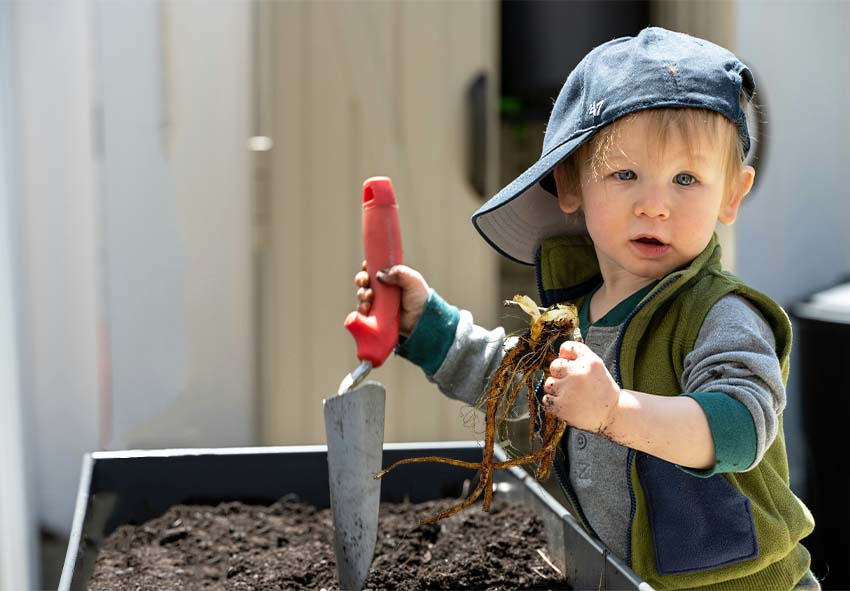
Propagating Dicentra offers gardeners an opportunity to expand their plant collection and share the beauty of these beloved perennials with others. Some common propagation methods for Dicentra include:
- Seeds: Dicentra plants can be propagated from seeds, providing an economical and rewarding way to expand your garden. To start Dicentra from seeds, you can sow them indoors in early spring, about 8-10 weeks before the last frost date in your area. Use a seed-starting mix and sow the seeds thinly on the surface, lightly pressing them into the soil. Once the seedlings have developed their first true leaves and the threat of frost has passed, they can be transplanted into the garden, spacing them according to their mature size.
- Division: Division is another effective method for propagating Dicentra plants and is best done in early spring or fall when the plant is dormant. To divide Dicentra, start by carefully digging up the entire plant, taking care not to damage the roots. Replant the divisions in prepared soil, spacing them according to their mature size, and water thoroughly to settle the soil around the roots.
- Cuttings: Propagating Dicentra from stem cuttings is a reliable method that allows you to create new plants from existing ones. Take stem cuttings from healthy, established Dicentra plants in summer when the stems are actively growing and have not yet become woody. Remove any lower leaves from the cutting, leaving only a few at the top, and dip the cut end in rooting hormone to encourage root development. Plant the cutting in a well-draining potting mix, keeping it evenly moist and providing bright, indirect light.
Whether you choose to start from seeds, divide your existing dutch plants, or take cuttings, each propagation method offers its own unique rewards and challenges. By following the guidelines outlined in this section and experimenting with different techniques, you’ll not only expand your Dicentra collection but also deepen your appreciation for these exquisite perennials.
Dicentra Care and Maintenance
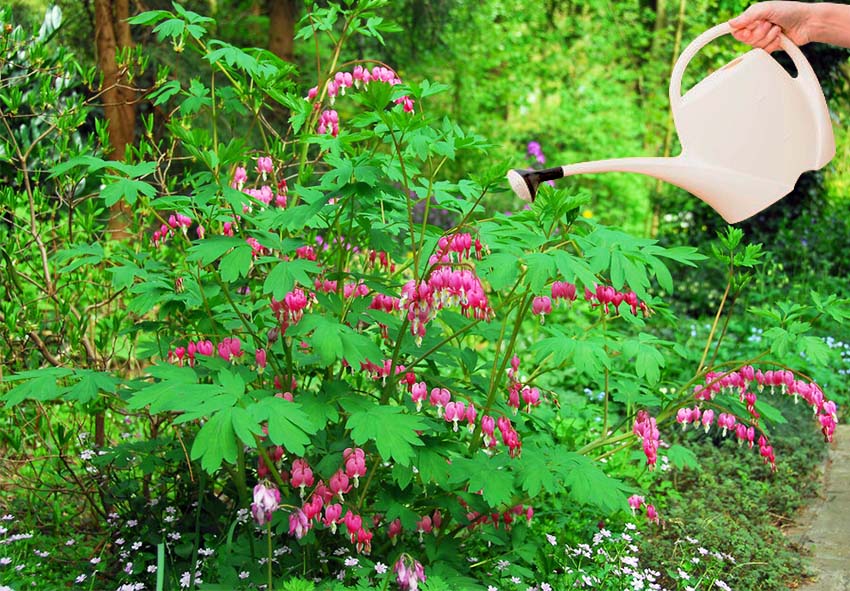
Caring for Dicentra is essential for ensuring their health and longevity in your garden. In this section, we’ll explore the key aspects of caring for Dicentra plants, from pruning and deadheading to fertilizing and winter care. By following these guidelines, you’ll be able to keep your Dicentra plants looking their best and blooming profusely season after season.
Pruning and Deadheading
Pruning and deadheading Dicentra plants are essential tasks to ensure their continued health and vigor. Deadheading, the removal of spent flowers, is particularly important for encouraging prolonged blooming and preventing the plant from expending energy on seed production.
To deadhead Dicentra, simply pinch or snip off the faded flowers as soon as they start to wilt and fade. This not only keeps the plant looking tidy but also stimulates the production of new flower buds, extending the blooming period throughout the growing season.
While Dicentra generally does not require extensive pruning, a light trim after the blooming period can help tidy up the plant and encourage new growth. However, be cautious not to prune too late in the season, as this can potentially remove flower buds for the following year.
Fertilizing Dicentra
Dicentra plants benefit from a balanced fertilizer applied in early spring as new growth emerges. Use a slow-release fertilizer or a diluted liquid fertilizer, following the manufacturer’s recommendations. Avoid overfertilizing, as excessive nutrients can lead to lush foliage at the expense of flowers.
Winter Care
As winter approaches, proactive measures are crucial to safeguard Dicentra plants from the harsh conditions that accompany the cold season. One of the most effective steps to take is to apply a layer of mulch around the base of the plants. This mulch acts as insulation, helping to regulate soil temperature and protect the delicate roots from frost damage. Organic materials such as shredded leaves, straw, or compost can be used as mulch, applied to a depth of 2-3 inches around the plant’s base.
In regions with particularly harsh winters, additional protection may be necessary. Consider covering Dicentra plants with a layer of straw or burlap to provide an extra barrier against freezing temperatures and icy winds. Ensure that the coverings are securely anchored to prevent them from being blown away by strong gusts of wind.
By taking these precautions to prepare Dicentra plants for winter, you can help ensure their survival and promote healthy growth when spring arrives.
Common Dicentra Pests and Diseases
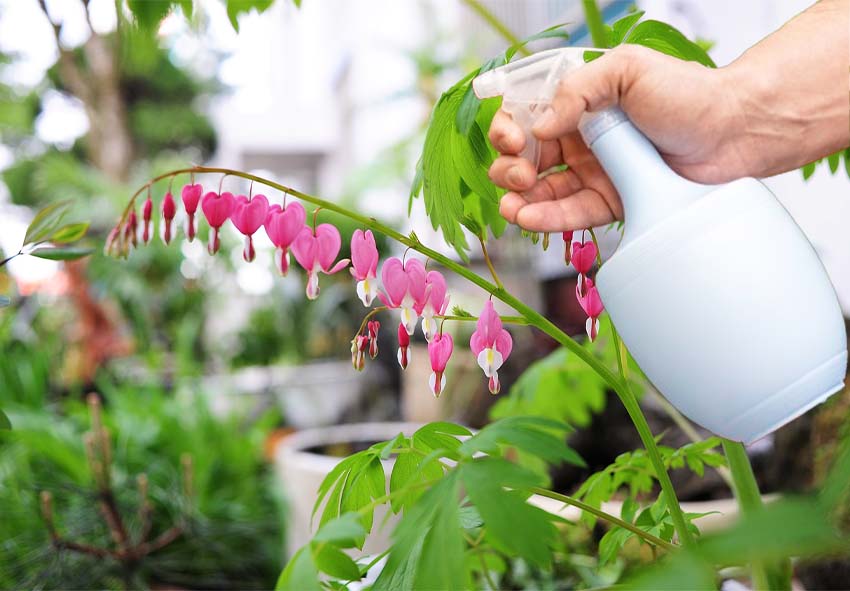
While Dicentra are generally resilient and low-maintenance, they are not immune to pests and diseases that can affect their health and appearance. In this section, we’ll delve into the common pests and diseases that may afflict Dicentra. By understanding the signs and symptoms of these issues and implementing effective control measures, you can protect your Dicentra plants and ensure they thrive in your garden.
Pest Identification
While Dicentra is relatively resistant to pests, it may occasionally fall victim to slugs, or snails. Keep an eye out for signs of pest infestation, such as distorted foliage or chewed leaves, and take appropriate measures to control the pests. Pests affecting Dicentra may also include:
- Aphids: Dicentra plants may occasionally attract aphids, which can distort foliage and cause damage to the plant. Inspect the undersides of leaves for clusters of small, soft-bodied insects and treat infestations promptly.
- Slugs and Snails: While Dicentra is relatively resistant to pests, slugs and snails may occasionally feed on its tender foliage, leaving behind ragged edges and holes in the leaves. Monitor for slime trails and chewed leaves, especially during periods of high humidity, and take appropriate measures to control these pests.
- Spider Mites: Spider mites are another potential pest that can infest Dicentra plants, particularly in dry, dusty conditions. Look for fine webbing and stippling on the leaves, as well as a bronzed or yellowish appearance. Regularly spray the foliage with a strong stream of water to dislodge spider mites, and consider using insecticidal soap or neem oil for severe infestations.
- Leaf Miners: Leaf miners are tiny larvae that feed on the tissues inside leaves, creating distinctive serpentine tunnels or blotches. While Dicentra is not a preferred host for leaf miners, occasional infestations may occur. Remove and destroy affected leaves to prevent the spread of the larvae, and consider applying a botanical insecticide if necessary.
Disease Prevention
Dicentra plants are susceptible to fungal diseases such as powdery mildew, particularly in humid conditions. To prevent diseases, ensure proper air circulation around the plants, avoid overhead watering, and maintain good garden hygiene by removing debris and dead plant material.
Using Dicentra in the Landscape
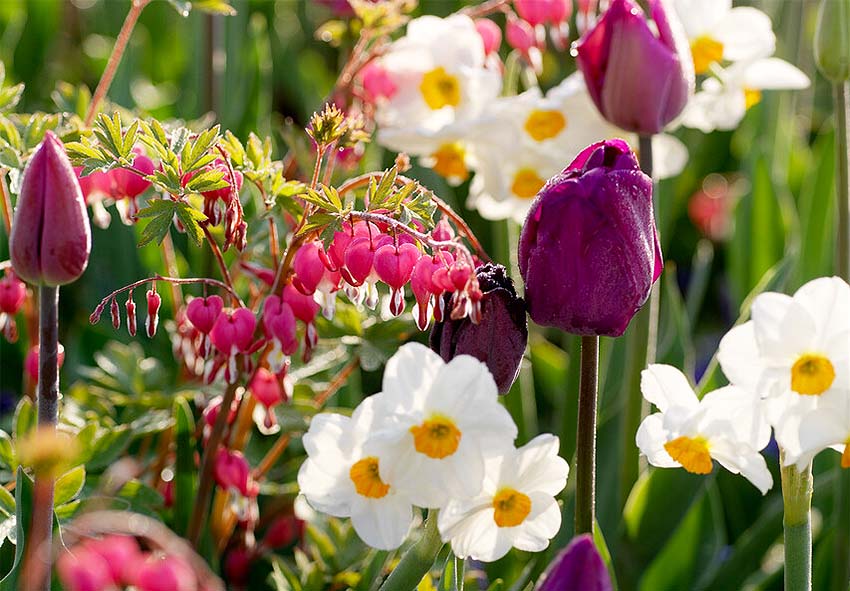
Using Dicentra in the landscape adds a touch of elegance and charm, thanks to its graceful foliage and distinctive heart-shaped flowers. These versatile plants thrive in shady areas, making them ideal for planting beneath trees, along woodland edges, or in shaded borders. Dicentra’s soft, arching stems and delicate blooms create a romantic atmosphere in the garden, complementing other shade-loving perennials like hostas, ferns, and astilbes. Whether used as a focal point or massed in drifts, Dicentra adds a timeless beauty to any landscape design.
Garden Design Ideas
Dicentra’s graceful arching stems and delicate flowers make it a charming addition to any garden landscape. Plant it alongside other shade-loving perennials such as hostas, ferns, and astilbes for a beautiful woodland garden effect. Here are some popular garden design ideas with Dicentra:
- Shade Gardens: Incorporate Dicentra into shaded garden areas to add color and interest where sunlight is limited. Pair with other shade-loving plants like hostas, ferns, and astilbes for a lush, layered effect.
- Woodland Gardens: Create a woodland retreat by planting Dicentra beneath the canopy of trees, where dappled sunlight filters through the foliage. Combine with native woodland plants like trilliums, wild ginger, and foamflowers for a naturalistic look.
- Mixed Borders: Use Dicentra to soften the edges of mixed borders, where it can provide a graceful contrast to taller perennials and shrubs. Blend with flowering plants like bleeding heart companions, such as brunnera, heuchera, and tiarella, for a harmonious planting scheme.
- Rock Gardens: Integrate Dicentra into rock gardens or alpine beds for a splash of color and whimsy amidst the rocky terrain. Plant in well-draining soil and position where it will receive morning sunlight and afternoon shade for best results.
Container Gardening
Dicentra also thrives in containers, making it an excellent choice for patios, balconies, and other small spaces. Choose a large, deep container with adequate drainage holes, and fill it with a well-draining potting mix. Place the container in a partially shaded location and water regularly to keep the soil evenly moist.
Recap of Key Points
In conclusion, Dicentra plants are a delightful addition to any garden, offering a burst of color and charm in shady areas. By understanding their growing conditions, mastering proper care techniques, and addressing common pests and diseases, gardeners can enjoy healthy, vibrant Dicentra plants year after year.
Encouragement
We hope this comprehensive guide has equipped you with the knowledge and confidence to cultivate beautiful Dicentra plants in your own garden. Embrace the magic of these enchanting blooms and create a captivating garden sanctuary to enjoy for seasons to come.
Frequently Asked Questions (FAQs) about Dicentra
1. When is the best time to plant Dicentra in the garden?
Dicentra is best planted in the early spring or fall when the weather is cooler and the plants are dormant. This allows them to establish their root systems before the heat of summer or the cold of winter sets in.
2. How often should I water Dicentra plants?
Dicentra prefers consistently moist soil, especially during the growing season. Water the plants deeply whenever the top inch of soil feels dry to the touch, but avoid overwatering, as soggy soil can lead to root rot.
3. How do I prevent powdery mildew on my Dicentra plants?
Powdery mildew is a common fungal disease that affects Dicentra plants, especially in humid conditions. To prevent powdery mildew, ensure proper air circulation around the plants by spacing them adequately and avoiding overcrowding. Water the plants at the base to keep the foliage dry, and remove any infected leaves promptly to prevent the spread of the disease.
4. Can I grow Dicentra in containers?
Yes, Dicentra can be grown in containers, provided that the containers have adequate drainage and the plants receive the appropriate amount of sunlight and water. Choose a large, deep container to accommodate the plant’s root system, and use a well-draining potting mix. Be sure to water the plants regularly, as container-grown plants may dry out more quickly than those in the ground.
5. Can I order Holland Dicentra from your online store?
Yes, you can! Our online store Dutch-bulbs.com offers a wide selection of Dicentra plants, including different varieties and colors. We take pride in providing top-quality plants that are carefully cultivated and shipped with care to ensure they reach you in perfect condition. Visit our online store to explore our collection and place your order for a delightful addition to your home or garden.
Published: 30.04.2024
